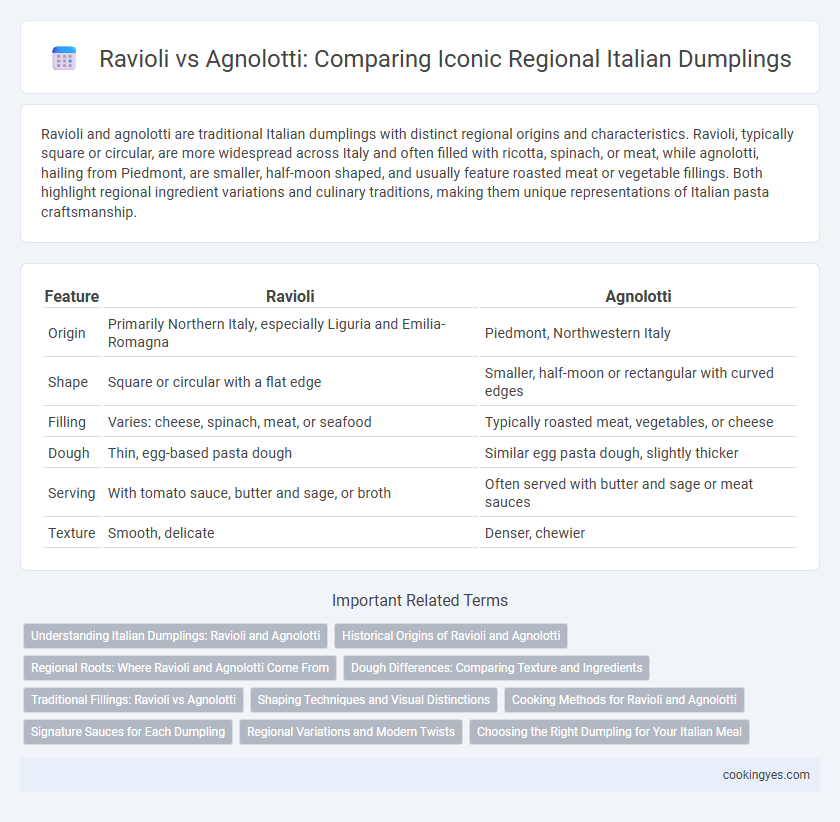Ravioli and agnolotti are traditional Italian dumplings with distinct regional origins and characteristics. Ravioli, typically square or circular, are more widespread across Italy and often filled with ricotta, spinach, or meat, while agnolotti, hailing from Piedmont, are smaller, half-moon shaped, and usually feature roasted meat or vegetable fillings. Both highlight regional ingredient variations and culinary traditions, making them unique representations of Italian pasta craftsmanship.
Table of Comparison
| Feature | Ravioli | Agnolotti |
|---|---|---|
| Origin | Primarily Northern Italy, especially Liguria and Emilia-Romagna | Piedmont, Northwestern Italy |
| Shape | Square or circular with a flat edge | Smaller, half-moon or rectangular with curved edges |
| Filling | Varies: cheese, spinach, meat, or seafood | Typically roasted meat, vegetables, or cheese |
| Dough | Thin, egg-based pasta dough | Similar egg pasta dough, slightly thicker |
| Serving | With tomato sauce, butter and sage, or broth | Often served with butter and sage or meat sauces |
| Texture | Smooth, delicate | Denser, chewier |
Understanding Italian Dumplings: Ravioli and Agnolotti
Ravioli and agnolotti are traditional regional Italian dumplings with distinct characteristics and fillings reflecting their geographic origins; ravioli typically feature a square shape with diverse fillings including cheese, spinach, or meat, common in Northern and Central Italy. Agnolotti, usually smaller and crescent-shaped, are native to Piedmont and filled primarily with roasted meat or vegetables, offering a richer, more concentrated flavor profile. Both dumplings highlight Italy's regional culinary diversity, showcasing unique dough textures and stuffing compositions that cater to local tastes and historical influences.
Historical Origins of Ravioli and Agnolotti
Ravioli originated in Northern Italy, particularly in Liguria and Lombardy, dating back to the 14th century as a convenient way to use leftover ingredients stuffed within pasta dough. Agnolotti, native to the Piedmont region, emerged during the Renaissance era and traditionally feature smaller, crescent-shaped parcels filled with roasted meat or vegetables. Both dumplings showcase regional culinary traditions, with ravioli often square or rectangular and agnolotti distinctively folded to preserve specific filling textures.
Regional Roots: Where Ravioli and Agnolotti Come From
Ravioli originates from Northern Italy, particularly the Liguria and Piedmont regions, featuring square or circular shapes often filled with cheese, spinach, or meat. Agnolotti is deeply rooted in Piedmont, characterized by smaller, crescent-shaped pasta parcels typically stuffed with roasted meat or vegetables. Both dumplings showcase distinct regional culinary traditions, reflecting local ingredients and historical influences in Northern Italian cuisine.
Dough Differences: Comparing Texture and Ingredients
Ravioli dough typically features a higher water content and finely milled durum wheat flour, resulting in a smooth, tender texture ideal for holding diverse fillings. Agnolotti dough often incorporates eggs and uses a blend of softer flours, producing a firmer bite with a slightly denser consistency. These differences in ingredients and hydration levels create distinct textures that complement the regional fillings and culinary traditions of northern Italy.
Traditional Fillings: Ravioli vs Agnolotti
Traditional ravioli fillings typically include ricotta cheese, spinach, and nutmeg or a meat-based mixture such as ground beef and pork, reflecting the culinary heritage of regions like Tuscany and Emilia-Romagna. Agnolotti fillings are often simpler and highlight roasted meats like braised beef or veal combined with fresh herbs, emphasizing Piedmont's rustic flavors. Both dumplings showcase regional Italian terroirs, but ravioli tend to embrace richer, creamier mixtures while agnolotti highlight savory, slow-cooked meat fillings.
Shaping Techniques and Visual Distinctions
Ravioli typically features a square or rectangular shape with crimped edges created using a rolling pin and cutter, emphasizing uniformity and sealed pockets for varied fillings. Agnolotti are characteristically smaller, half-moon or crescent-shaped, crafted by folding pasta sheets over the filling and pinching the edges, resulting in a more rustic appearance. The visual distinction lies in ravioli's precise, geometric form versus agnolotti's curved, hand-pressed structure, reflecting regional shaping techniques from Northern and Central Italy.
Cooking Methods for Ravioli and Agnolotti
Ravioli are typically boiled in salted water until they float, ensuring a tender texture that holds rich fillings like ricotta or spinach, while agnolotti are often briefly boiled and then finished in a saute pan with butter or sage to enhance their smaller, thicker shape and meat-based fillings. The cooking method for ravioli emphasizes gentle boiling to preserve delicate pasta sheets, whereas agnolotti's shorter boil and saute provide a caramelized flavor and firmer bite. Both regional dumplings require precise timing to avoid overcooking and maintain their distinctive textures.
Signature Sauces for Each Dumpling
Ravioli, traditionally paired with rich tomato-based or creamy butter and sage sauces, highlight the delicate stuffing with flavors that complement mushrooms, cheese, or meat fillings. Agnolotti, native to the Piedmont region, are often served with robust butter and sage sauces or light meat reductions that accentuate their savory, often roasted meat or vegetable fillings. The signature sauces for each dumpling emphasize regional ingredients, enhancing the unique textures and flavors distinctive to Ravioli and Agnolotti traditions.
Regional Variations and Modern Twists
Ravioli and Agnolotti represent distinct regional Italian dumplings, with Ravioli originating primarily from Liguria and Tuscany, characterized by square or circular shapes filled with ricotta, spinach, or meat. Agnolotti hail from Piedmont, featuring smaller, typically half-moon shapes stuffed with roasted meat or vegetables, showcasing the region's rich culinary heritage. Modern twists on both include innovative fillings like pumpkin or truffle-infused cheeses and sauces that blend traditional flavors with contemporary techniques, reflecting evolving Italian gastronomy.
Choosing the Right Dumpling for Your Italian Meal
Ravioli and Agnolotti differ significantly in shape, filling, and regional origin, influencing your choice for an authentic Italian meal. Ravioli, typically square or circular, are commonly filled with ricotta cheese, spinach, or meat and hail from Northern Italy, especially Liguria and Tuscany. Agnolotti are smaller, crescent-shaped dumplings from Piedmont, often stuffed with roasted meat or vegetables, offering a richer, earthier flavor profile that complements hearty sauces.
Ravioli vs Agnolotti for regional Italian dumplings Infographic

 cookingyes.com
cookingyes.com